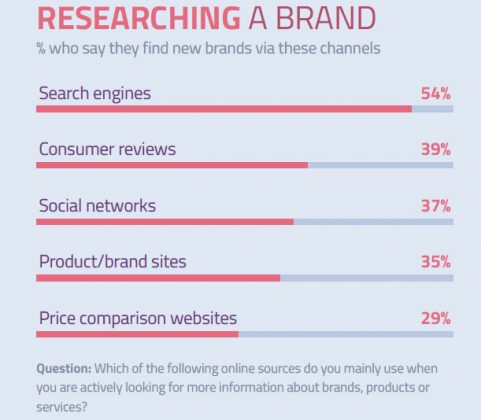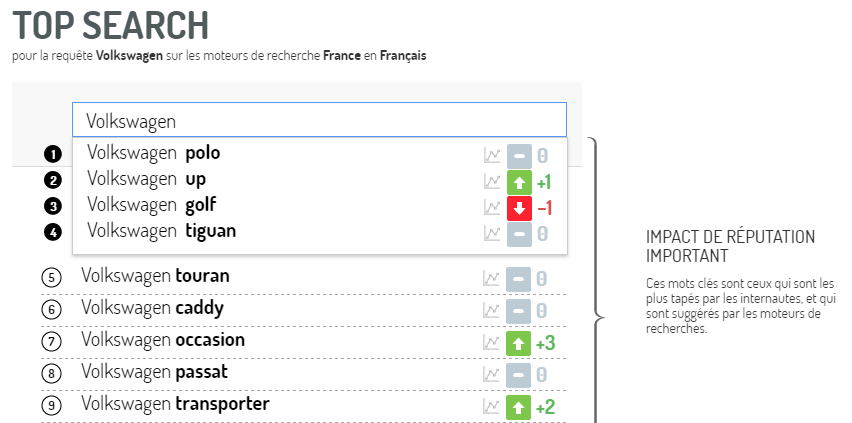How to Analyze a Customer's Path On Social Media
In the course of their journey, a customer or prospective client of a brand navigates an ecosystem of sites, chat rooms, and social networks in order to form an idea about a product, ask for opinions, or reassure their decision to either buy or bail. Analyzing the customer experience is essential to understanding the needs of consumers and their interactions with peers. The question is, how exactly should brands conduct this analysis?
Social media and web searches are essential at all stages:

Search for brand information: engines, reviews, and social networks. Source: GlobalWebIndex
- Preparing a purchase (61%) and buying (55%) are the two main uses of the Internet in France (this post was originally written for Digimind's French blog).
- Almost a quarter of individuals (23%) consult social networks before a purchase
- 30% of Internet users visit the sites of the brands
- When searching for a product or service, Internet users visit an average of 7.5 websites.
- In the discovery and search phases of a brand, search engines, TV ads, consumer reviews, peer recommendations and social networks are the 5 most used sources by consumers.
Sources: GlobalWeb Index, Credoc, Comscore for UPS-Kantar Study TNS Sofres / Connected Life
Discovering brands on search engines and social networks:
When shopping, consumers are look for brand information on search engines. One way to evaluate and analyze the research of internet searches for a product, a brand, or a service is to check out Big Data Google.
By analyzing the Google, you’ll get valuable insights on the research trends of your customers, as the data is largely based on the most popular searches.
For example, most searches this month for the Volkswagen brand were related to the "small models" first (UP, Polo), star Golf and Tiguan. More interestingly, the analysis of current research trends compared to the previous month reveal that used vehicle searches increased significantly. This type Google data is integral when analyzing the concerns of online consumers.

Customer journey: the discovery and research phase on engines
Understanding the consumer journey on social media:
Consumers also rely on opinion sites (in 39% of cases), and social networks (37%) to discover information about a brand.
This is why we must define a scope of sources to analyze precisely, not to mention all the sources specific to a particular sector. It’s necessary to define consumer opinion sites that are essential for your market, locally and internationally. For example TripAdvisor for Hotels and Restaurants, and Yelp for Businesses.
On social networks like Facebook or Twitter, consumers also look for products and brands as a part of the buying phase. They ask for advice in order to discover brands in this preliminary step, before their final selection—with their friends on Facebook, with their followers on Twitter, or with accounts managed by the brands themselves. So consider scanning the conversations of Internet users related to your products and those of your competitors on these social networks.
Looking for advice about the brand:
Once the consumer has chosen a product or a brand, he or she will seek advice from friends—in real life, or on social—on the use of the specific product. Unlike the previous phase where the type of product was not yet chosen, this is a phase of evaluation. Specific criteria is considered to assure a purchase over several other brands (criteria like price, quality, design, delivery, Financial conditions, return conditions, technical performances, etc.).
The purchase and delivery phase:
This is the most critical phase—the one that encounters the most negative experiences: bad customer service, delayed delivery, damaged product, etc.
For this phase, it will be necessary to go beyond Facebook or Twitter and also examine forums. Consumers often develop their criticisms of a brand or a service on specialized forums, given the fact a forum provides more room to rant.
Physical contact with the brand, and user experience:
In these two phases, also called 1st moment of truth and 2d moment moment of truth, consumers share their first physical contact with the product and then their first experiences as users. It’s on Instagram, Facebook, Pinterest, opinion sites, forums, and blogs that we find the most conversational and visual representations of these two phases.
Brand Ambassadors:
Ideally, after having a memorable customer experience, consumers can become ambassadors for your brand. This influences future buyers (word-of-mouth recommendation is used by 36% of consumers during the discovery phase of a product).
Now, how does a brand detect an ambassador? By monitoring messages associated with the brand, both frequent and positive, and then analyzing the authority, legitimacy, activity, and commitment of the messaging. Based on the analysis of these criteria, a brand can determine a consumer’s degree of influence as an ambassador—thus concluding that person’s path to peak consumerism.
Written by Austin Williams
A New York based writer and pop culture enthusiast, Austin is your best bet if you ever want to know about the MTA or Love & Hip Hop.

